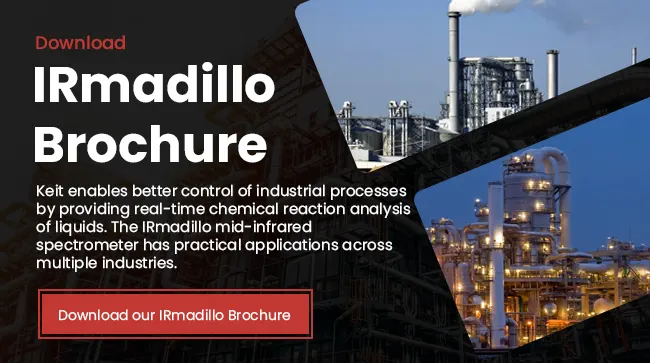Real-Time Measurement of the Fuel Ethanol Propagation Process
Abstract
Optimizing the performance of the propagation tank is one of the first, and arguably most crucial, steps in the process of running a successful and efficient ethanol plant, and measuring the performance effectively is critical to achieving this. The aim of any plant operating a propagation tank is to transfer the heathiest possible yeast to fermentation at the optimal point for ethanol conversion. Through the use of the IRmadillo you can quantify key components of the propagation cycle reliably and in real time to make sure you hit the optimal point every single batch.

Introduction
Yeast is a biological substance and its healthy growth is dependent on managing its environment closely. Sugar levels need to be maintained at around 2% to ensure the yeast is fed while avoiding osmotic stress. Oxygen levels need to be regulated to promote biomass gain and minimize sugar-to-ethanol conversion pathways caused by anerobic conditions. Likewise, nitrogen sources are key for the yeast to encourage metabolism and increase yeast counts. To control performance and optimize these conditions effectively, high quality real time measurements are needed to ensure that operators can map their entire propagation process and quickly assess the impact of any process changes.
Process spectrometers allow continuous and detailed measurement of chemical concentrations in real time. The majority of infrared spectrometers are based on near infrared light, which is fundamentally less informative than mid infrared light. Conventional mid infrared spectrometers (which often use a Fourier transform and so are referred to as "FTIR spectrometers") have sensitive moving parts and fragile fiber probes – making them wholly unsuitable for production environments such as ethanol refineries. The IRmadillo is a process analyzer built using FTIR spectroscopy, but with static optics, removing the need for moving mirrors or fiber probes, and dramatically improving stability, reliability, and ruggedness.

Figure 1: IRmadillo predictions (gray) plotted with the customer's HPLC measurements (red). Concentration values are measured in %wt/V.
Example Use Case
This application note presents data from a European ethanol plant, measuring 8 different chemical species typically seen by HPLC but provided to the plant in real time across the entire propagation cycle by the IRmadillo.
By monitoring the sugars, the activity of any glucoamylase becomes clear as the mash is broken down into glucose. Operators can use these values to assess enzyme dosage and avoid unnecessary - and expensive - enzyme dosing while still maintaining sugar levels suitable for optimal growth. Ethanol production can be used to evaluate oxygen levels in the propagator and make changes to improve the aerobic conditions for the yeast. The presence of lactic and acetic acids can be used to determine if antibiotics should be used. Glycerol levels can be used to assess if changes should be made to keep the yeast happy and productive.

Table 1: Measurement accuracy (RMSECV) for species of interest
Additionally, the IRmadillo can be trained to go beyond the species typically measured by HPLC and look at values such as PAN (Primary Amino Nitrogen) and FAN (Freely Available Nitrogen). Nitrogen is a vital nutrient for the yeast, and it is introduced into the process through the addition of chemicals such as urea or ammonia. As with any additives, reducing the amount used is a direct saving so finding the balance is key.
Conclusion
By real-time monitoring of the propagation tank, operators are able to send higher quality yeast to the fermenter at the optimal point in the yeast's growth cycle. This ensures that the fermenter has the highest possible chance of achieving complete conversion of sugars to ethanol.
Find out more about using the IRmadillo in the fuel ethanol process.


